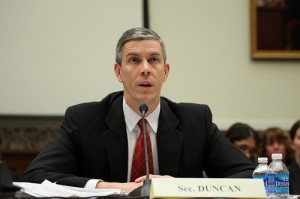
In a op-ed last week in the Times, columnist Joe Nocera, in an article titled “Why We Need For-Profit Colleges,” comes to the defense of the embattled institutions, which have been increasingly up in arms since Secretary of Education Arne Duncan announced in June new steps to protect students from what the department terms “ineffective career college programs.”
“There is nothing inherently wrong with the idea of for-profit education,” Nocera writes. “The for-profits have flaws, but so do nonprofits, with their bloated infrastructure, sky-high tuition, out-of-control athletic programs and resistance to change. In a country where education matters so much, we need them both.”
I agree. And I don’t, on the face of it, disagree with any of Nocera’s arguments for why this is so.
However, I do find some fault with Nocera’s assertion that for-profits and non-profits are essentially “separate but equal” institutions, both of them with inconsequentially different flaws.
For-profit institutions contend the new rules are unnecessary and unfair, and would limit educational opportunities for the primarily low-income and minority student bodies that make up the bulk of their enrollments.
While I hesitate to suggest for-profit institutions are either overplaying their victimhood or being deceptive outright, something about their argument that their works are, above all else, for the greater good of students generally—and students of color and low-income students specifically—smacks of disingenuousness to me.
According to Education Department figures, “students at for-profit institutions represent 12 percent of all higher education students, 26 percent of all student loans and 46 percent of all student loan dollars in default.”
If those numbers aren’t staggering in and of themselves, also consider the fact that for-profit institutions and their various advocates have spent an estimated $12 million to combat Duncan and the Education Department’s push for greater oversight of their industry since 2010.
Those hardly seem like the discretionary resources of a cash-strapped, systemically neglected public university or community college to me.
Unlike public K-12 schools, where teachers argue (justifiablly in some cases, admittedly) that a lack of resources, coupled with years of systemic neglect and mismanagement, should temper the degree to which they’re ultimately judged with regard to student performance, for-profit colleges and universities, given their most recent largesse, seem to have a wealth of resources at their disposal.
As Duncan has said: “We’re asking companies that get up to 90 percent of their profits from taxpayer dollars to be at least 35 percent effective. This is a perfectly reasonable bar and one that every for-profit program should be able to reach.”
Couple this with the fact that these institutions, which remain in the distinct minority as a share of the total number of post-secondary institutions across the country, receive, by themselves, 26 percent of all the financial aid (in the form of Pell Grants and other forms of support) issued by the federal government, and it’s hard to see their plight as being one and the same with that of public universities and community colleges, or feel sympathy for their claims that they’re being picked on unfairly by Duncan and the Obama administration.
On their website, the Association of Private Sector Colleges and Universities, an advocacy group for the interests of for-profit colleges and universities, states that its “core values” include, among other things, a “dedication to integrity, accountability and excellence in career and professional higher education.”
Those are undoubtedly respectable ideals I think for any education institution to pursue. But at a time when student loan defaults continue to rise, I believe it’s imperative that APSCU and its members not only embrace the value of accountability in its literature but earnestly live up to it in practice.
If APSCU and its constituents believe so genuinely in the education they’re offering their students, this should be a policy they can readily get behind. To be sure, if you’re already rigorously vetting your own processes for inefficiencies or areas where student interests might be better served, the new rules will merely have a placebo effect. If not, however, it will, if as effective as advertised, unmask those who seek to prey upon the most valuable yet vulnerable resource our society has: our young people.
We’ve already seen what can occur when institutions implicitly invested with the public’s trust take their eyes off the ball in the name of ever-engorged profit margins. Now, many experts believe that higher education student loan defaults may be another potentially disastrous bubble waiting to explode. I believe it would behoove us to not drop the ball twice.